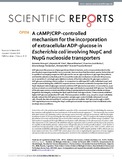Mostrar el registro sencillo del ítem
A cAMP/CRP-controlled mechanism for the incorporation of extracellular ADP-glucose in Escherichia coli involving NupC and NupG nucleoside transporters
| dc.creator | Almagro Zabalza, Goizeder | es_ES |
| dc.creator | Viale, Alejandro M. | es_ES |
| dc.creator | Montero Macarro, Manuel | es_ES |
| dc.creator | Muñoz Pérez, Francisco José | es_ES |
| dc.creator | Baroja Fernández, Edurne | es_ES |
| dc.creator | Mori, Hirotada | es_ES |
| dc.creator | Pozueta Romero, Javier | es_ES |
| dc.date.accessioned | 2019-07-01T09:27:37Z | |
| dc.date.available | 2019-07-01T09:27:37Z | |
| dc.date.issued | 2018 | |
| dc.identifier.issn | 2045-2322 | |
| dc.identifier.uri | https://hdl.handle.net/2454/33506 | |
| dc.description.abstract | ADP-glucose is the precursor of glycogen biosynthesis in bacteria, and a compound abundant in the starchy plant organs ingested by many mammals. Here we show that the enteric species Escherichia coli is capable of scavenging exogenous ADP-glucose for use as a glycosyl donor in glycogen biosynthesis and feed the adenine nucleotide pool. To unravel the molecular mechanisms involved in this process, we screened the E. coli single-gene deletion mutants of the Keio collection for glycogen content in ADP-glucose-containing culture medium. In comparison to wild-type (WT) cells, individual ∆nupC and ∆nupG mutants lacking the cAMP/CRP responsive inner-membrane nucleoside transporters NupC and NupG displayed reduced glycogen contents and slow ADP-glucose incorporation. In concordance, ∆cya and ∆crp mutants accumulated low levels of glycogen and slowly incorporated ADP-glucose. Two-thirds of the glycogen-excess mutants identified during screening lacked functions that underlie envelope biogenesis and integrity, including the RpoE specific RseA anti-sigma factor. These mutants exhibited higher ADP-glucose uptake than WT cells. The incorporation of either ∆crp, ∆nupG or ∆nupC null alleles sharply reduced the ADP-glucose incorporation and glycogen content initially witnessed in ∆rseA cells. Overall, the data showed that E. coli incorporates extracellular ADP-glucose through a cAMP/CRP-regulated process involving the NupC and NupG nucleoside transporters that is facilitated under envelope stress conditions. | en |
| dc.description.sponsorship | This work was partially supported by the Comisión Interministerial de Ciencia y Tecnología and Fondo Europeo de Desarrollo Regional (Spain) (grant numbers BIO2013-49125-C2-1-P and BIO2016-78747-P). A.M.V. is a Career Researcher of the Consejo Nacional de Investigaciones Cientificas y Técnicas de Argentina (CONICET) and Professor of Micribiology at the National University of Rosario (U.N.R., Argentina). A.M.V. expresses his gratitude to the Ministerio de Educación y Cultura, the Consejo Superior de Investigaciones Científicas, and the Public University of Navarra for financial support. | en |
| dc.format.extent | 15 p. | |
| dc.format.mimetype | application/pdf | en |
| dc.language.iso | eng | en |
| dc.publisher | Nature Research | en |
| dc.relation.ispartof | Scientific Reports, (2018) 8:15509 | en |
| dc.rights | © The Author(s) 2018. This article is licensed under a Creative Commons Attribution 4.0 International License, which permits use, sharing, adaptation, distribution and reproduction in any medium or format, as long as you give appropriate credit to the original author(s) and the source, provide a link to the Creative Commons license, and indicate if changes were made. The images or other third party material in this article are included in the article’s Creative Commons license, unless indicated otherwise in a credit line to the material. If material is not included in the article’s Creative Commons license and your intended use is not permitted by statutory regulation or exceeds the permitted use, you will need to obtain permission directly from the copyright holder. | en |
| dc.rights.uri | http://creativecommons.org/licenses/by/4.0/ | |
| dc.subject | ADP-glucose | en |
| dc.subject | Escherichia coli | en |
| dc.subject | NupC | en |
| dc.subject | NupG | en |
| dc.subject | cAMP/CRP | en |
| dc.title | A cAMP/CRP-controlled mechanism for the incorporation of extracellular ADP-glucose in Escherichia coli involving NupC and NupG nucleoside transporters | en |
| dc.type | info:eu-repo/semantics/article | en |
| dc.type | Artículo / Artikulua | es |
| dc.contributor.department | IdAB. Instituto de Agrobiotecnología / Agrobioteknologiako Institutua | es |
| dc.rights.accessRights | info:eu-repo/semantics/openAccess | en |
| dc.rights.accessRights | Acceso abierto / Sarbide irekia | es |
| dc.identifier.doi | 10.1038/s41598-018-33647-w | |
| dc.relation.projectID | info:eu-repo/grantAgreement/MINECO//BIO2013-49125-C2-2-P/ES/ | en |
| dc.relation.projectID | info:eu-repo/grantAgreement/ES/1PE/BIO2016-78747-P | en |
| dc.relation.publisherversion | https://doi.org/10.1038/s41598-018-33647-w | |
| dc.type.version | info:eu-repo/semantics/publishedVersion | en |
| dc.type.version | Versión publicada / Argitaratu den bertsioa | es |
| dc.contributor.funder | Universidad Pública de Navarra / Nafarroako Unibertsitate Publikoa | es |
Ficheros en el ítem
Este ítem aparece en la(s) siguiente(s) colección(ones)
La licencia del ítem se describe como © The Author(s) 2018. This article is licensed under a Creative Commons Attribution 4.0 International
License, which permits use, sharing, adaptation, distribution and reproduction in any medium or
format, as long as you give appropriate credit to the original author(s) and the source, provide a link to the Creative
Commons license, and indicate if changes were made. The images or other third party material in this
article are included in the article’s Creative Commons license, unless indicated otherwise in a credit line to the
material. If material is not included in the article’s Creative Commons license and your intended use is not permitted
by statutory regulation or exceeds the permitted use, you will need to obtain permission directly from the
copyright holder.




